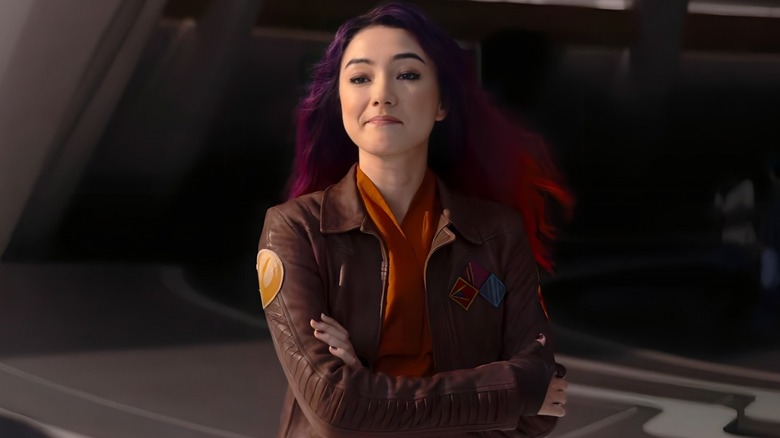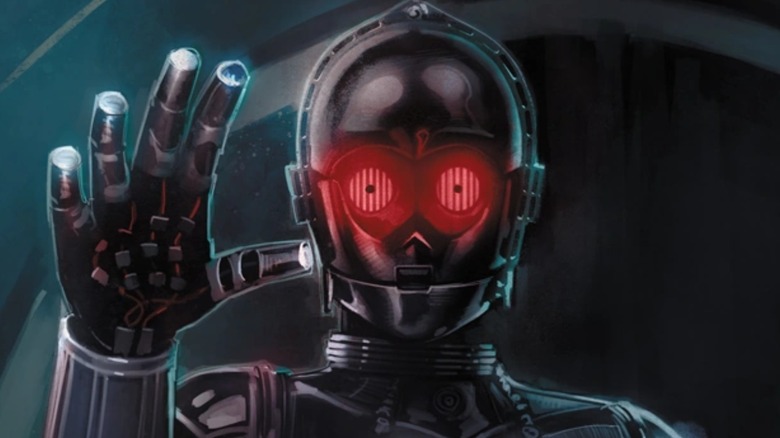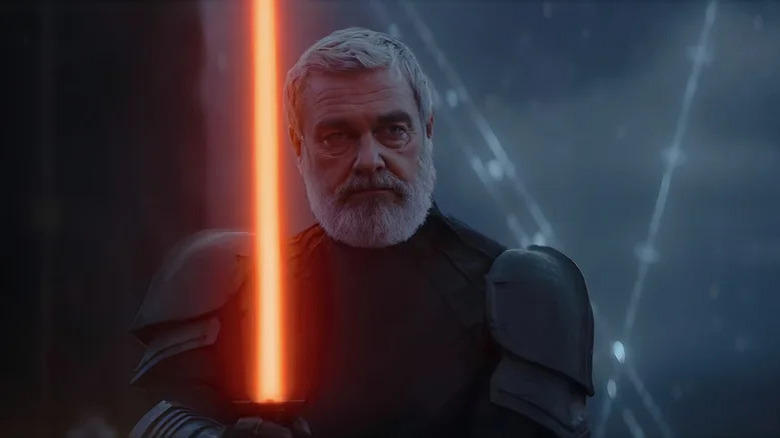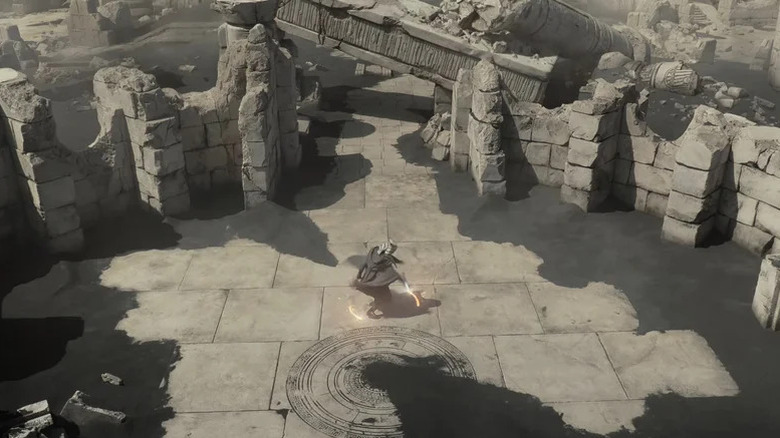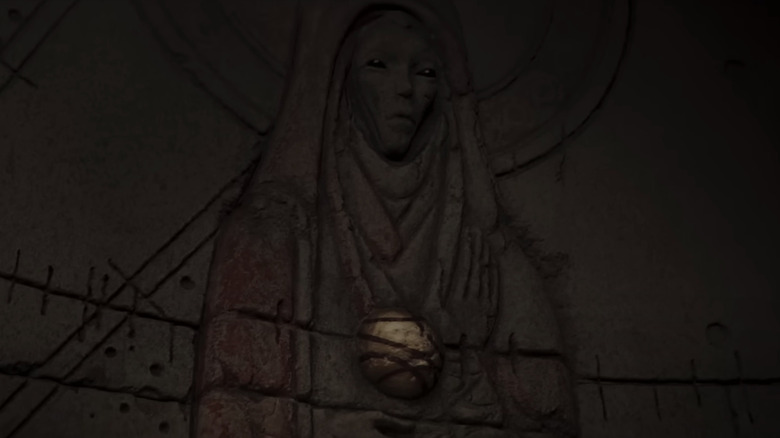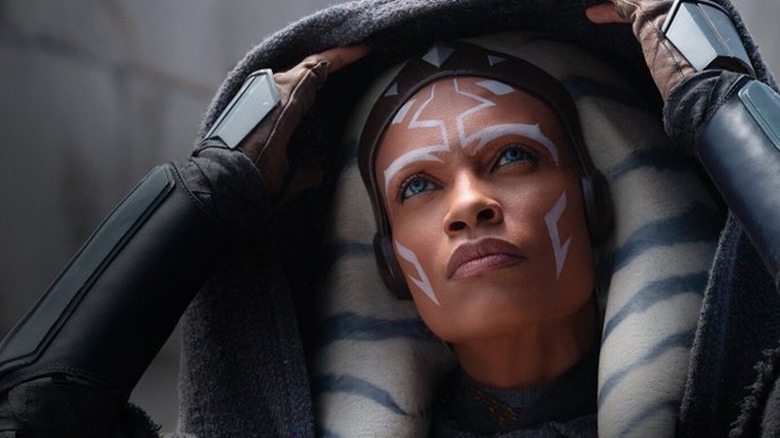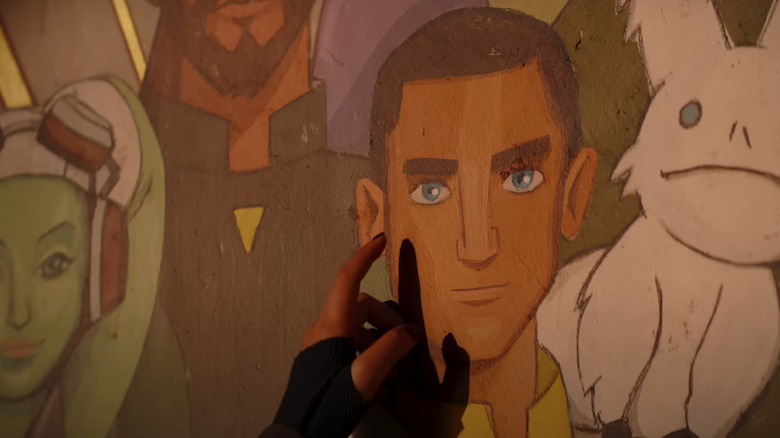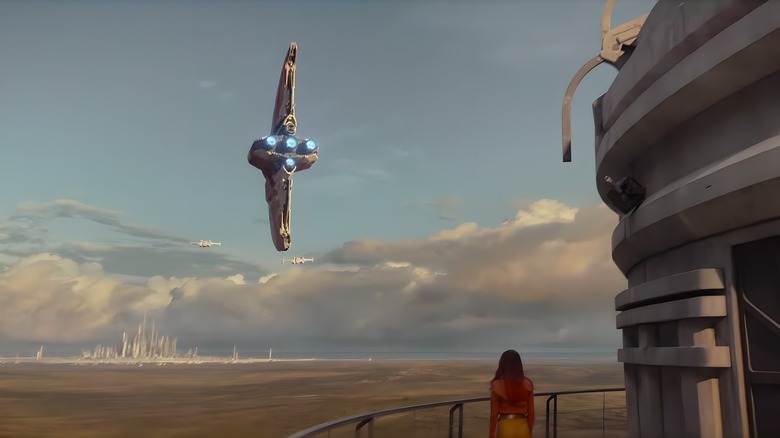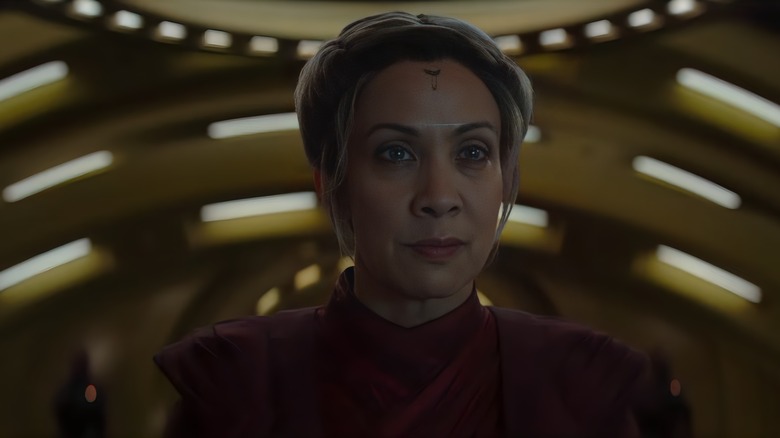Ahsoka Episode 1: Star Wars Easter Eggs You Might Have Missed
Contains spoilers for "Ahsoka" Season 1, Episode 1 — "Master and Apprentice"
In many ways, "Ahsoka" is what the Disney+ "Star Wars" shows have been building toward. After Ahsoka Tano (Rosario Dawson) made her first live-action appearance in "The Mandalorian" Season 2 and Bo-Katan Kryze (Katee Sackhoff) inserted herself into the main character picture of the same show, it's been clear that the small-screen leg of the Galaxy Far, Far Away isn't about to shy away from the events of "Star Wars: The Clone Wars" and "Star Wars Rebels."
Indeed, the "Ahsoka" Season 1 premiere brings the animated shows front and center. With characters like Ahsoka, Sabine Wren (Natasha Liu Bordizzo), Hera Syndulla (Mary Elizabeth Winstead), Huyang (David Tennant), and even Ryder Asadi (Clancy Brown) now firmly in the live-action mix, the show has so much going on that it can be easy to miss the stealthier Easter eggs and references to past events that "Master and Apprentice" features. Let's take a look at some of the best ones.
A fun homage to a deadly comic book droid
If you were to guess which character gets the first close-up shot of the "Ahsoka" Season 1 premiere, you probably wouldn't choose a random, black-tinted 3PO unit on the ship transporting Morgan Elsbeth (Diana Lee Inosanto). Despite its blink-and-you-miss-it role in the events, the protocol droid gets a frankly disproportionate amount of love from the camera. Even after it gets destroyed during Baylan Skoll's (Ray Stevenson) and Shin Hati's (Ivanna Saknno) attack, we see Huyang (David Tennant) casting a pointed look at its wrecked torso as a worker carries it through the Home-1 hangar.
While this particular droid is probably just a regular old 3PO unit, its distinctive paint job and the amount of attention the show gives it are clearly a nod at 0-0-0 , aka Triple-Zero. The pitch-black torture droid hails from the "Star Wars" comics. A combination of a dangerous personality matrix and the body of a humble protocol unit, Triple-Zero combines C-3PO's verbosity and unassuming appearance with the mind of an unrepentant sadist. Naturally, the droid tends to hang out with the equally villainous R2-D2 expy BT-1.
Unless the live-action "Star Wars" universe plays uncharacteristically fast and loose with the character's origins, it's unlikely that the particular black 3PO unit we see in "Master and Apprentice" will gain a pair of red eyes and become Triple-Zero. Still, the visual similarity is clearly no accident.
Baylan Skoll believes in the Darth Vader school of hallway combat
Ahsoka Tano might be the Jedi dropout who was trained by Anakin Skywalker (Hayden Christensen), but Baylan Skoll is the one who fights like Darth Vader. Skoll immediately demonstrates how dangerous he is while rescuing former Magistrate Morgan Elsbeth (Diana Lee Inosanto). Without a care for his opponents, he almost casually destroys a troop of guards, deflecting and cutting with his red lightsaber in easy motions that belie their deadliness.
The brutal sequence is essentially a better-lit version of the best scene in "Rogue One: A Star Wars Story," where Vader tears his way through the Rebel forces who are trying to escape with the Death Star plans. Skoll's large, black-clad presence is just one helmet and a creepy breathing apparatus short of a perfect Vader impression. The moves he uses are also very similar throughout the scene, and at one point, he even takes time to use Vader's patented "lift-and-Force choke" staple on one particularly hapless opponent.
The visual similarity between Skoll's attack and Vader's hallway slaughter is interesting since it stealthily suggests that the characters pose a similar threat ... which could effectively make Skoll the de facto successor to Vader's role, given that "Ahsoka" takes place after "The Return of the Jedi." It remains to be seen how powerful Skoll really is when push comes to shove, but the way the series premiere uses the "Rogue One" Easter egg to establish him as a force to be reckoned with suggests an extremely fascinating battle between him and Ahsoka at some point down the line. After all, their respective apprentices already cross swords at the end of the episode.
Ahsoka still loves her special move from The Clone Wars
Ahsoka Tano's dual-wielding and penchant for reverse grip techniques have long established her as one of the most innovative lightsaber fighters in the franchise. Like several other Force users, she also seems to have developed a preference for specific, tried-and-tested moves. Even in this, she proves that she likes to think outside the box. In "Star Wars: The Clone Wars," she has been known to use her lightsabers to create improvised entrances to the next floor, and as "Master and Apprentice" proves, she's honed this skill into an art form.
As eagle-eyed fans already noticed in the "Ahsoka" trailer, an early cool moment in the series premiere features Ahsoka using the Force to spin her lightsabers around her, cutting a hole in the ground in order to enter a hidden basement chamber. The moment serves as a clear call-back to "The Clone Wars," but as it turns out, it's just the beginning. When enemy droids turn up and challenge her for the map she just obtained, she busts out the move again by jumping back into the chamber and literally undermining multiple opponents by spin-cutting the floor from underneath their feet.
What makes the moment so fun is that the smirk on her face just before she pulls this off reveals what a huge flex this is. With all the Force moves and fighting skills at her disposal, Ahsoka has no need to use this specific move, as she soon proves by effortlessly outclassing the droids until they activate their self-destruct mode. It seems that she's just delighted to find an excuse to use her classic trick from the animated series — and really, why wouldn't she be? It's a cool trick.
Order 66 survivors sure enjoy their orbs and puzzles
Ahsoka's introductory scene in "Master and Apprentice" features way more than cool lightsaber action and improvised tunneling. The secret chamber she discovers features a complicated puzzle that she must solve in order to get the map orb that she seeks. By concentrating on the Force, Ahsoka is able to figure out the situation and solve the puzzle. This, combined with the fact that the prize is an orb, will no doubt cause the gamer section of the fandom to nod their heads in approval.
Anyone who's played "Star Wars Jedi: Fallen Order" and its sequel, "Star Wars Jedi: Survivor," is no doubt familiar with the games' fondness of using orbs as key components in the various puzzles the protagonist, Ahsoka's fellow Order 66 survivor Cal Kestis, has to solve. Granted, the mechanics of these video game puzzles are somewhat different than the low-key way Ahsoka solves her mystery. Still, it's hard to believe that the fact that "Ahsoka" features an Order 66 survivor solving an orb-themed puzzle is anything other than a neat homage to the Electronic Arts video games.
That Fulcrum callsign means more than you think
Ahsoka's mission to acquire the map orb may be successful, but the mood takes a sudden turn for the dark when Home-1 contacts her ship to deliver the news that Morgan Elsbeth has escaped. However, the brief call also includes a reference that arguably carries far more historical weight than anything Elsbeth can possibly hope to achieve in "Ahsoka."
When Huyang answers Home-1's call, he identifies Ahsoka's ship by its callsign: "Fulcrum." If you've only kept up with the live-action side of the "Star Wars" franchise, this is just a word. If you're familiar with the animated series, though, you may very well recognize the significance of the term.
Fulcrum is the designation of an important and influential faction of Rebel agents who contributed heavily to toppling the Empire, and their ranks have included heavyweights like Cassian Andor (Diego Luna). As it happens, Ahsoka is the creator of the Fulcrum system and the most prominent agent to use the moniker, so it's both incredibly cool and extremely fitting that the title lives on as her callsign.
The mural brings the Rebels animation style to live action
When Governor Ryder Asadi gives his big speech on Lothal, the viewer might notice the weirdly cartoonish mural in the background. Its art style clashes with basically everything we've seen in live-action "Star Wars" before ... but then again, that's precisely the point, isn't it? After all, said work of art is quite possibly the most obvious nod to the fact that "Ahsoka" owes everything to the animated shows that came before it.
Known as the Spectres Mural, Sabine Wren painted this picture of the titular squad near the end of "Star Wars Rebels," and visited it just before embarking on a journey to find Ezra Bridger (Eman Esfandi) with Ahsoka. The mural's extremely "Rebels"-accurate appearance in "Ahsoka" essentially confirms that the show isn't hiding its roots, even when it comes to minor art style updates. For those who know its history, it also provides a potential explanation as to why Sabine avoids the ceremony that takes place on the same platform where the mural is. After all, since the mission to find Ezra was clearly a failure and she seems to be quite bitter about that, it's hardly a surprise that she'd want to avoid such a potentially triggering situation.
Two flyover scenes, two different vibes
Speaking of "Star Wars Rebels," the viewers who remember the show's final moments might get a dose of déjà vu during the "Ahsoka" Episode 1 scene where the main character's T-6 Jedi shuttle flies over Sabine's tower on its way to Lothal's capital. The scene is a faithful reproduction of one at the end of "Rebels." Of course, as Sabine's long hair reveals, years have passed between the two flyovers, and their aftermaths go in drastically different ways. In "Rebels," the scene is followed by an uplifting hope spot where Sabine dons her Mandalorian helmet and joins Ahsoka to find Ezra. "Ahsoka," however, finds the former master and apprentice in far cooler terms, with Sabine barely willing to tolerate Ahsoka and the Togruta openly lamenting how difficult their relationship has become.
As of the end of "Master and Apprentice," it's unclear what happened to wreck the pair's relationship. For now, all we know is that "The Mandalorian" Season 2 already showed that Ahsoka has never stopped trying to find Thrawn and Ezra, while Sabine seems to have stayed on Lothal for quite some time. Still, it's pretty clear that the pair's fraught relationship will be repaired before long ... and when this happens, don't be surprised if we get some more subtle references to classic "Rebels" scenes.
A Nightsister revealed
When we first meet her in "The Mandalorian" Season 2, Morgan Elsbeth rules the city of Calodan as its Magistrate, and she's ... surprisingly tough, actually. After her forces fail, she decides to battle Ahsoka herself. Armed with little more than an attitude and some serious skills with a Beskar spear, she puts up a decent fight in the climactic, samurai-style showdown of "Chapter 13: The Jedi."
In "Ahsoka" Episode 1, we finally find out how the leader of a random Imperial holdout is as skilled as Elsbeth. As it turns out, she's more than just Thrawn's old lackey — she casually mentions that she's also one of the Nightsisters of Dathomir.
This powerful group of dark Force users is an ominous presence in "Star Wars: The Clone Wars," though they seem to be largely extinct by the time "Ahsoka" takes place. As such, apart from Elsbeth herself, it's unlikely that the Nightsisters will play much of a role in "Ahsoka." Still, the offhand revelation that the former Magistrate is a member of this ancient sect is a nice little addition that serves to further connect the animated "Star Wars" shows and the live-action ones.
